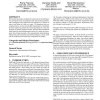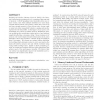5 search results - page 1 / 1 » Achieving sub-second IGP convergence in large IP networks |
CCR
2005
13 years 4 months ago
2005
We describe and analyse in details the various factors that influence the convergence time of intradomain link state routing protocols. This convergence time reflects the time req...
CONEXT
2005
ACM
13 years 6 months ago
2005
ACM
We first show by measurements that BGP peering links fail as frequently as intradomain links and usually for short periods of time. We propose a new fast-reroute technique where ...
ICC
2009
IEEE
13 years 11 months ago
2009
IEEE
— In this paper, we propose a game theoretical approach to tackle the problem of the distributed formation of the uplink tree structure among the relay stations (RSs) and their s...
ICDCS
2003
IEEE
13 years 10 months ago
2003
IEEE
Internet radio and television stations require significant bandwidth to support delivery of high quality audio and video streams to a large number of receivers. IP multicast is a...
CONEXT
2006
ACM
13 years 10 months ago
2006
ACM
Running the Border Gateway Protocol (BGP), the Internet’s interdomain routing protocol, consumes a large amount of memory. A BGP-speaking router typically stores one or more rou...



